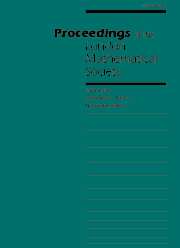Article contents
Finite subgroups of F4([Copf ]) and E6([Copf ])
Published online by Cambridge University Press: 01 January 1997
Abstract
The isomorphism types of finite Lie primitive subgroups of the complex Lie groups $E_{6} ( \C )$ and $F_4 ( \C )$ are determined. Here, we call a finite subgroup of a complex Lie group $G$ {\sl Lie primitive\/} if it is not contained in a proper closed subgroup of $G$ of positive dimension. Induction can be used to investigate subgroups which are not Lie primitive. Some additional information is provided, such as the characters of these finite subgroups on some small-dimensional modules for the Lie groups.
In studying these groups, we mainly use two rational linear representations of the universal covering group $\widetilde E$ of $E_6(\C)$, namely a 27-dimensional module (there are two inequivalent ones), denoted by $\K$, and the adjoint module. In particular, we make heavy use of the characters of $\widetilde E$ on these modules. The group $F_4(\C)$ occurs in $\widetilde E$ as the stabilizer subgroup of a vector in $\K$. The finite simple groups of which a perfect central extension occurs in $F_4(\C)$ or $E_6(\C)$ are:
via $G_2$: $Alt_5$, $Alt_6$, $L(2,7)$, $L(2,8)$, $L(2,13)$, $U(3,3)$,
via $F_4$: $Alt_7$, $Alt_8$, $Alt_9$, $L(2,17)$, $L(2,25)$, $L(2,27)$, $L(3,3)$, ${}^3D_4(2)$, $U(4,2)$, $O(7,2)$, $O^{+}(8,2)$,
via $E_6$: $Alt_{10}$, $Alt_{11}$, $L ( 2 , 11)$, $L(2,19)$, $L(3,4)$, $U(4,3)$, ${}^2F_4(2)'$, $M_{11}$, $J_2$.
This list has been found using the classification of the finite simple groups. On the basis of this list, the finite Lie primitive subgroups are found to be either the normalizers of one of these subgroups or of one of the two elementary abelian $3$-groups found by Alekseevskii.
1991 Mathematics Subject Classification: 20K47, 20G40, 17B45, 20C10.
- Type
- Research Article
- Information
- Copyright
- London Mathematical Society 1997
- 23
- Cited by


